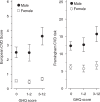Gender-specific association of psychological distress with cardiovascular risk scores
- PMID: 20331387
- PMCID: PMC3440612
- DOI: 10.3109/02813431003648131
Gender-specific association of psychological distress with cardiovascular risk scores
Abstract
Objective: To examine the gender differences in the association of psychological distress with cardiovascular disease (CVD) risk scores using two different CVD risk assessment models.
Design and setting: A cross-sectional, population-based study from 1997 to 1998 in Pieksämäki, Finland.
Subjects: A population sample of 899 (399 male and 500 female) middle-aged subjects.
Main outcome measures: The 10-year risk for CVD events was calculated using the European SCORE model and the Framingham CVD risk prediction model. Psychological distress was measured using the 12-item General Health Questionnaire (GHQ-12). Study subjects were allocated into three groups according to their global GHQ-12 -scores: 0 points, 1-2 points, and 3-12 points.
Results: Psychological distress was associated with higher mean CVD risk scores in men. Men in the highest GHQ group (3-12 points) had significantly higher mean European CVD risk score (3.6 [SD 3.3]) compared with men in the lowest group (0 points) (2.5 [SD 2.6]), the difference being 1.1 (95% CI 0.4 to 1.9). The p-value for linearity between the three GHQ groups was 0.003. The Framingham CVD risk prediction model yielded similar results: 15.7 (SD 10.2) vs. 12.3 (SD 9.6), the difference 3.4 (95% CI 1.0 to 6.0) and p-value for linearity 0.008. No significant association was observed in women.
Conclusion: A gender-specific association was found between psychological distress and cardiovascular risk scores. These results highlight the importance of identifying men with psychological distress when assessing CVD risk.
Figures
Similar articles
-
Gender difference in the association between Framingham Risk Score with cardio-metabolic risk factors and psychological distress in patients with metabolic syndrome.Diabetes Metab Syndr. 2020 Mar-Apr;14(2):71-75. doi: 10.1016/j.dsx.2019.12.009. Epub 2020 Jan 3. Diabetes Metab Syndr. 2020. PMID: 31991295
-
Psychological distress measured by the GHQ-12 and mortality: a prospective population-based study.Scand J Public Health. 2011 Aug;39(6):577-81. doi: 10.1177/1403494811414244. Epub 2011 Jul 13. Scand J Public Health. 2011. PMID: 21752849
-
Psychological distress and C-reactive protein: do health behaviours and pathophysiological factors modify the association?Eur Arch Psychiatry Clin Neurosci. 2011 Jun;261(4):277-84. doi: 10.1007/s00406-010-0134-x. Epub 2010 Aug 14. Eur Arch Psychiatry Clin Neurosci. 2011. PMID: 20711599
-
Psychosocial stress and cardiovascular disease: pathophysiological links.Behav Med. 2002 Winter;27(4):141-7. doi: 10.1080/08964280209596039. Behav Med. 2002. PMID: 12165968 Free PMC article. Review.
-
Sense of Purpose in Life and Cardiovascular Disease: Underlying Mechanisms and Future Directions.Curr Cardiol Rep. 2019 Oct 31;21(11):135. doi: 10.1007/s11886-019-1222-9. Curr Cardiol Rep. 2019. PMID: 31673815 Free PMC article. Review.
Cited by
-
Correlation between psychological distress and C-reactive protein : Comment on Puustinen et al., "Psychological distress and C-reactive protein: do health behaviours and pathophysiological factors modify the association?" (Eur Arch Psychiatry Clin Neurosci 2011;261:277-84).Eur Arch Psychiatry Clin Neurosci. 2012 Apr;262(3):269-70. doi: 10.1007/s00406-011-0276-5. Epub 2011 Nov 16. Eur Arch Psychiatry Clin Neurosci. 2012. PMID: 22086651 No abstract available.
-
Associations between police officer stress and the metabolic syndrome.Int J Emerg Ment Health. 2011;13(4):243-56. Int J Emerg Ment Health. 2011. PMID: 22900458 Free PMC article.
-
Does present use of cardiovascular medication reflect elevated cardiovascular risk scores estimated ten years ago? A population based longitudinal observational study.BMC Public Health. 2011 Mar 2;11:144. doi: 10.1186/1471-2458-11-144. BMC Public Health. 2011. PMID: 21366925 Free PMC article.
-
How to promote exercise in primary care.Scand J Prim Health Care. 2010 Sep;28(3):130-1. doi: 10.3109/02813432.2010.504045. Scand J Prim Health Care. 2010. PMID: 20698728 Free PMC article. No abstract available.
-
Poor psychological health and 8-year mortality: a population-based prospective cohort study stratified by gender in Scania, Sweden.BMJ Open. 2022 Nov 22;12(11):e056367. doi: 10.1136/bmjopen-2021-056367. BMJ Open. 2022. PMID: 36414308 Free PMC article.
References
-
- Bjorkelund C, Andersson-Hange D, Andersson K, Bengtsson C, Blomstrand A, Bondyr-Carlsson D, et al. Secular trends in cardiovascular risk factors with a 36-year perspective: Observations from 38- and 50-year-olds in the Population Study of Women in Gothenburg. Scand J Prim Health Care. 2008;26:140–6. - PMC - PubMed
-
- Everson-Rose SA, Lewis TT. Psychosocial factors and cardiovascular diseases. Annu Rev Public Health. 2005;26:469–500. - PubMed
-
- Kubzansky LD, Cole SR, Kawachi I, Vokonas P, Sparrow D. Shared and unique contributions of anger, anxiety, and depression to coronary heart disease: A prospective study in the normative aging study. Ann Behav Med. 2006;31:21–9. - PubMed
MeSH terms
LinkOut - more resources
Full Text Sources
Medical

